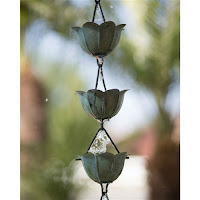A Little Background
Kusari Doi have been a part of Japanese home design for many years. Wait, "what is Kusari Doi?", you ask. Well that is the Japanese name for these eye catching structures. And no, they do not fall from the sky! Rain chains function to divert rain that drains from your roof or gutters downwards to the ground. They accomplish this due to the surface tension of water clinging onto the chain sending a wonderful display of water away from your foundation. Who knew something from so long ago can still be used today? If you are in the market for a new rain chain, we compiled a list of key points to keep in mind...Ridiculously Low Maintenance
Lets face it, gutters are hard to clean and maintain year round. They get clogged with the most random of things; leaves, pine cones, sticks, moss, etc. Unclogging them requires patience and elbow grease. Sometimes climbing up a ladder to stand on the roof and dig through chunks of debris. Well with a rain chain, your downspout is one less part of your gutter system you have to clean. Leaving you with time to do other things like watching your beautifully hung rain chain work of art.Aesthetics
Rain chains come in many different designs. So instead of a normal rigid looking downspout, you can add color and texture to your home. They don't have to resemble actual chains. You may choose to have a repeating fish pattern which is really popular, or opt for pure copper cut into attractive shapes. Either way you go with these you cant go wrong. When it rains you will be rewarded with a sight that might bring a tear to your eye! Sorry there are no rain chains to catch the water coming from your eyes.Hanging Location
Normally your new rain chain should be hung in the same spot a downspout would be located. There's a pre-cut hole making installation simple and all the water running off will be channeled to that spot increasing the look of the rain chain. But you can always be creative and hang them wherever you please. They can be hung from porches, wooden posts, sheds, etc. When hanging your rain chain be sure to choose a location that is visible and will provide you with adequate water.
Anchoring Your Rain Chain
Where there is rain, often times wind is sure to follow. Properly securing your rain chain is easier and more fun than you might think. Normally you would use a pan that attaches to the chain. The pan will retain a portion of the water and prevent splattering dirt onto surrounding surfaces. They come in different materials like copper for example. If you choose the more creative route the options are many. For starters you can try a rain barrel to anchor your chain. This is a great idea because rain barrels are multipurpose and look great adding to the flair of your rain chain. Another option is using large clay or stone pots filled with river pebbles. The water drains nicely and the pot will fit well with your landscape.
So if a rain chain suits your garden needs here are the key points once again:
So if a rain chain suits your garden needs here are the key points once again:
- Low Maintenance - Unlike conventional downspouts, rain chains never get clogged and no dangerous deep cleaning required.
- Aesthetics - Aside from functionality, add to the beauty of your home and garden with differently designed rain chains.
- Hanging Location - Can be hung wherever you like, but preferably where large there's large quantities of water and should be made visible.
- Anchoring - Choose something heavy enough to eliminate swinging in the wind, and be imaginative with your design.


The least expensive CNC plasma cutting machine costs from minimum $4,000 up to as} $30,000. A low cost automatic edge banding machine is priced from $8,000 for woodworking. The high precision CNC knife cutters and digital cutting machines cost start round $15,800 for flexible supplies. CNC Baby Bottle Warmers machines are electro-mechanical units that manipulate machine store instruments using laptop programming inputs. It represents certainly one of two normal methods (3D printing know-how like SLA, SLS/SLM, and FDM being the other) to generate prototypes from a digital software file.
ReplyDelete